Basic Geometry
The perimeter of any polygon is calculated by finding the sum of the lengths of its sides.

The area of a region is defined as its amount of surface. The area for a rectangle is calculated by multiplying its sides:

If the units of and are , the unit of will be . In case of a square the area is simply the length of one of its sides squared ()
The distance of a circle is found by the formula , where is the radius - the line from the center of the circle straight to its edge.
(approximately)
Pythagorean Theorem
Given the lengths of 2 sides of a right angular triangle (a triangle of which one angle is 90 degrees), the length of the third size can be calculated. Given the formula which assumes and to be the sides adjacent to the right angle and to be the side opposite to the angle, one may find an unknown side length by solving the resulting equation.
